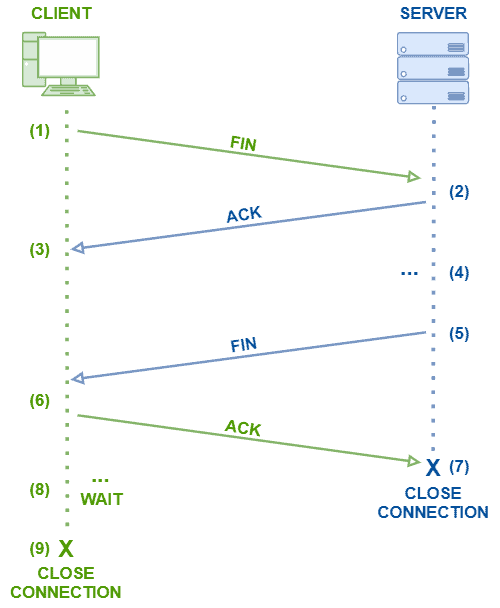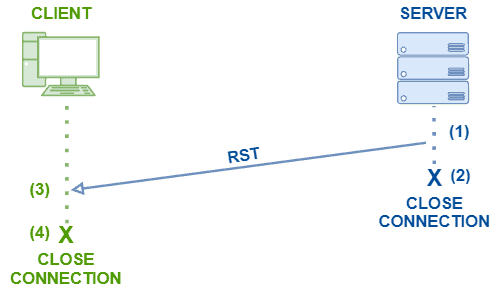1. 引言
在日常生活中,我们有很多方式来开始或结束一次对话。比如,见面时握手,告别时挥手示意,或者干脆转身离开。
在计算机网络中,也有类似的“信号”用于协调通信。如果使用的是 TCP 协议,那么 SYN、ACK、FIN 和 RST 就是这些通信的“信号”。
本文将重点讲解 TCP 中的两个关键控制信号:FIN 和 RST。我们会先回顾 TCP 的通信机制,再分别深入探讨 FIN 与 RST 的使用场景和行为差异,最后进行对比总结。
2. TCP 通信机制
TCP 是一种面向连接的协议,工作在 OSI 模型的传输层(第四层)。它通过建立连接来保证数据的可靠传输。
建立和关闭 TCP 连接时,会使用一系列控制消息作为通信的“信号”:
- SYN(Synchronize):用于请求建立连接
- ACK(Acknowledgment):用于确认收到某个消息
- FIN(Finish):用于优雅关闭连接
- RST(Reset):用于强制终止连接
TCP 通信通常以三次握手开始,使用 SYN 和 ACK 建立连接;以四次挥手结束,使用 FIN 和 ACK 关闭连接。当然,如果过程中出现异常,也可以使用 RST 直接中断连接。
3. FIN 消息详解
FIN 消息用于请求优雅地终止 TCP 连接。如果把连接比作对话,那么发送 FIN 就像是说:“我说完了,现在听你说”。
3.1 FIN 握手流程
当一方(比如客户端)想关闭连接时,会触发 FIN 握手流程:
- 客户端发送 FIN 给服务器
- 服务器收到 FIN 后发送 ACK 回复
- 客户端收到 ACK 后进入等待状态
- 服务器继续发送未完成的数据(如果有的话)
- 服务器发送 FIN 给客户端
- 客户端收到 FIN 后发送 ACK 回复
- 服务器收到 ACK 后关闭连接
- 客户端等待一段时间后关闭连接
这个过程总共进行了两次双向握手,因此也被称为四次挥手。
✅ 优点:确保双方都完成数据传输后再关闭连接。
⚠️ 注意:由于是双向关闭,每一方都要独立完成自己的 FIN 发送和 ACK 回复。

4. RST 消息详解
RST 消息用于强制终止一个 TCP 连接。还是用对话来类比,RST 就像是说:“我不说了,也不听你说了”,直接结束沟通。
4.1 RST 的行为流程
当一方发送 RST 后,流程如下:
- 服务器发送 RST 给客户端
- 服务器立即关闭连接
- 客户端收到 RST 后也关闭连接
整个过程非常简单粗暴,没有确认机制,也没有等待数据传完。

4.2 常见使用场景
- 收到一个不属于当前连接的数据包(比如连接已关闭)
- 收到重复的 SYN 请求(连接已存在)
- 服务器过载,无法处理新请求
- 攻击行为(如 TCP RST 攻击)
⚠️ 注意:RST 消息可以伪造,因此可能被用于中间人攻击(如 TCP Reset 攻击),强制中断合法连接。
5. FIN 与 RST 对比
| 特性 | FIN | RST |
|---|---|---|
| 关闭方式 | 优雅关闭 | 强制终止 |
| 是否需要双方确认 | ✅ 是 | ❌ 否 |
| 是否保证数据完整性 | ✅ 是 | ❌ 否 |
| 是否双向 | ✅ 是 | ❌ 单向 |
| 适用场景 | 正常通信结束 | 连接异常或错误 |
| 是否安全 | ✅ 较安全 | ⚠️ 可能被伪造 |
6. 总结
TCP 中的 FIN 和 RST 都用于关闭连接,但它们的使用场景和行为完全不同:
- FIN 是“礼貌”的结束方式,适用于正常通信结束,保证数据完整性。
- RST 是“暴力”的结束方式,适用于异常情况,不保证数据完整性,但能快速释放资源。
✅ 踩坑提醒:
- 服务端频繁出现 RST,可能意味着连接池配置不合理或存在网络异常
- 客户端收到 RST,可能是连接超时、服务端未监听端口或被主动中断
掌握这两者的区别,有助于我们更好地理解 TCP 协议的行为,排查网络问题,优化系统性能。